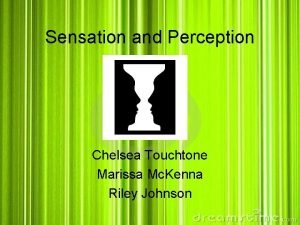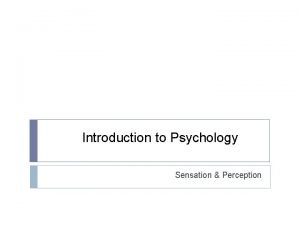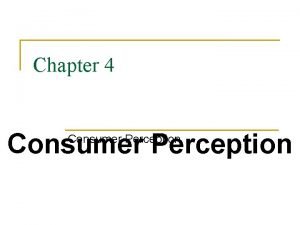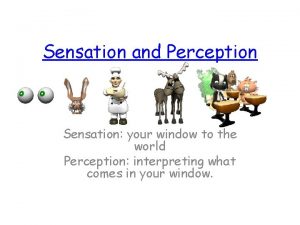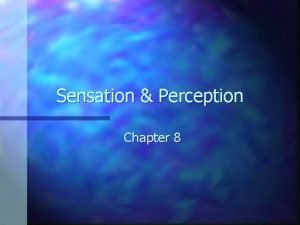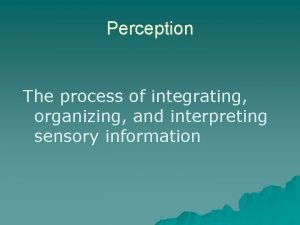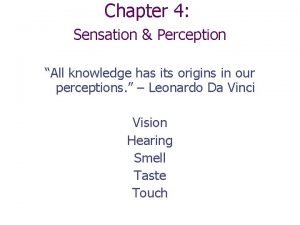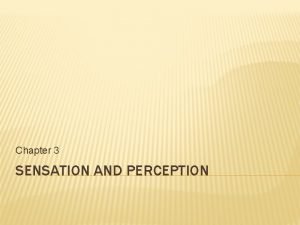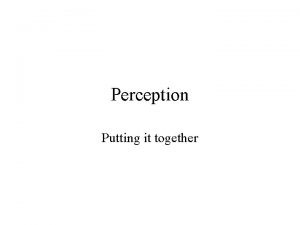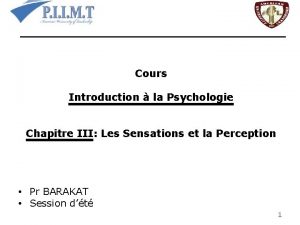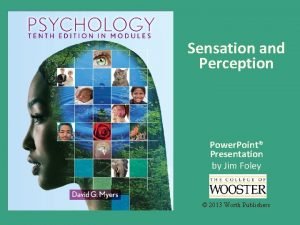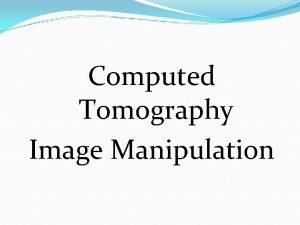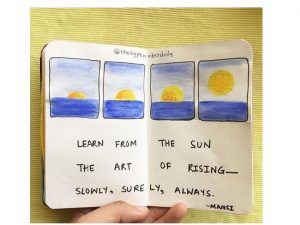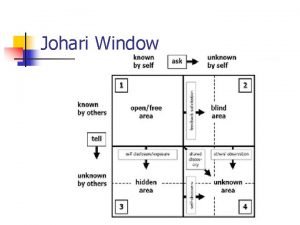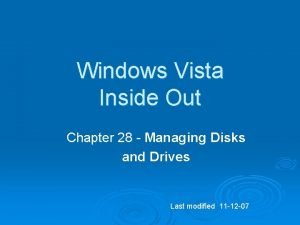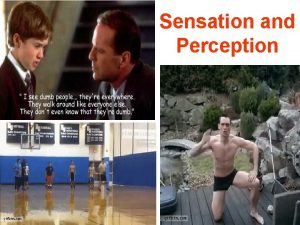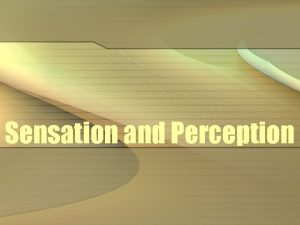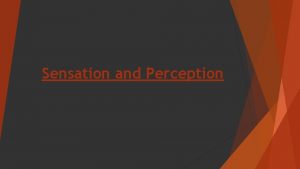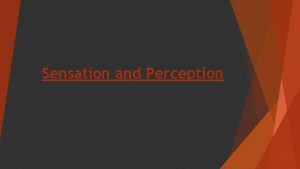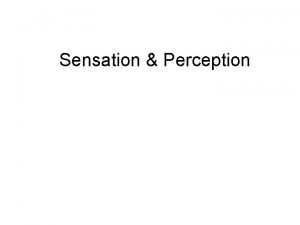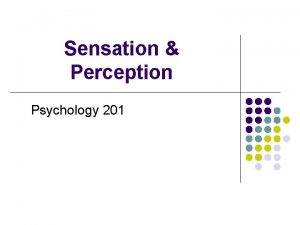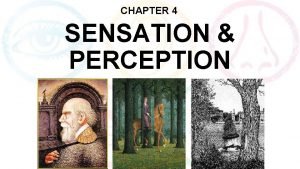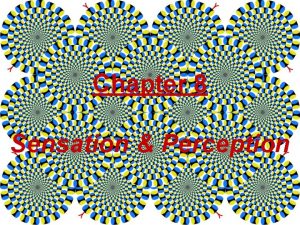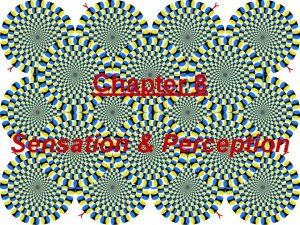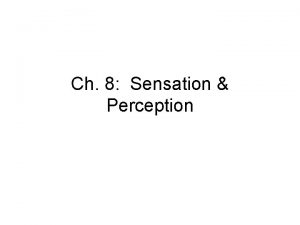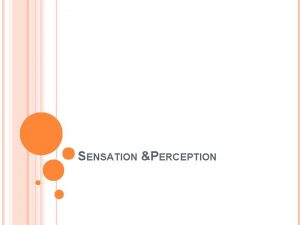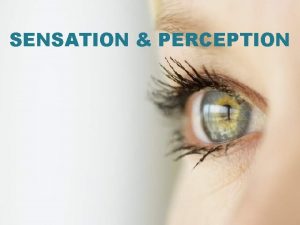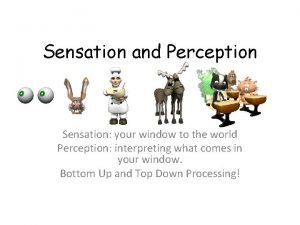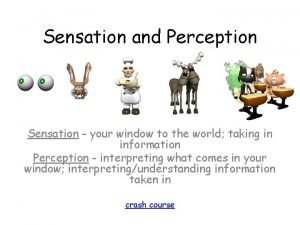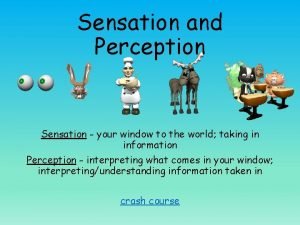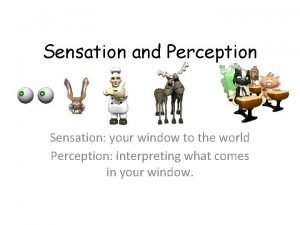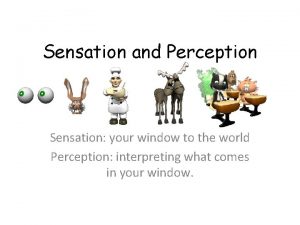Sensation and Perception An Introduction Sensation your window


























- Slides: 26

Sensation and Perception: An Introduction Sensation: your window to the world Perception: interpreting what comes in your window.

Sensation & Perception Sensation: The process by which our sensory receptors and nervous system receive stimulus from the environment ◦ Stimulation of sense organs Perception: The process of organizing and interpreting sensory information, enabling us to recognize meaningful objects and events.

Figure 4. 1 The distinction between sensation and perception

Selective Attention Selective Attention: the focusing of conscious awareness on a particular stimulus ◦ Five senses take in 11, 000 bits of info per second We consciously process about _____ ◦ Mind’s unconscious track processes other 10, 999, 960 bits

Selective Attention Selective Attention: the focusing of conscious awareness on a particular stimulus Cocktail party effect: your ability to attend to only one voice among the many Accidents: 80% of accidents each year due to driver distraction We stop talking during demanding situation ADHD: people with ADHD seem to lack the ability to be selectively attentive Unable to filter our unimportant stimuli to focus on important ones

Selective Attention http: //www. youtube. com/watch? v=v. JG 698 U 2 Mvo http: //www. simonslab. com/videos. html ◦ #2 IA ◦ #3 CB

Selective Inattention We are consciously “blind” to all but a tiny sliver of the immense array of visual stimuli before us ◦ Basketball Video Inattentional Blindness: failing to see visible objects when our attention is directed elsewhere Change Blindness: failing to notice changes in the environment ◦ After brief visual interruption, objects may appear/disappear http: //www. youtube. com/watch? v=Vkrr. Voz. ZR 2 c

Changing Stimulation to Sensation Transduction: The sensory process that _____ physical energy, such as light or sound waves, into the form of ________ Information goes from the senses to the thalamus, then to the various areas in the brain.

How does stimulation become perception? First, physical stimulation (like light waves from the butterfly) are transduced by the eye, where information about the wavelength and the intensity of the light is coded into neural signals. Second, the neural messages travel to the sensory cortex of the brain, where they become sensations of color, brightness, form, and movement. Finally, the process of perception interprets these sensations by making connections with memories, expectations, emotions, and motives in other parts of the brain. Stimulation Transduction Light waves Sensation Neural signals Perception

Sensation vs. Perception - Examples One receives stimulation through the senses, but it is a meaningless array of black and white splotches. We struggle to impose some organization upon the meaningless array we are sensing.

Thresholds Psychophysics: The study of how physical stimuli are translated into psychological experience ◦ What types of “energy” are we exposed to in a daily basis? X-rays, radio waves, ultraviolet, infrared, sound(high/low) frequencies ◦ “Shades” on our own senses are open just a crack – restricted awareness

Absolute Threshold Absolute Threshold: The minimum stimulation necessary to detect a particular light, sound, pressure, taste, or odor 50% of the time.

Absolute Threshold Absolute Threshold: To identify your absolute threshold for sound: ◦ Hearing specialist would expose each of your ears to varying sound levels. When you correctly detect the sound half of the time and the other half you do not, that is your absolute threshold. Absolute thresholds may vary with age. Sensitivity to high-pitched sounds declines with normal aging. ◦ Test your own absolute threshold for hearing at this site: http: //www. jimmyr. com/blog/hearingloss. html

Table 4 -1, p. 121

Signal Detection Theory Signal Detection Theory: states that sensation is not a simple present/absent or yes/no experience. ◦ It is not necessarily as simple as classical psychophysics makes it seem Instead, signal detection theory takes other factors into account: ◦ Physical Condition: you might miss more when overtired, for example ◦ Judgments (when something “goes bump in the night, ” you have to use your judgment to decide how bad it might be) ◦ Biases Basically, signal detection theory says detection depends partly on a person’s experience, expectations, motivation, and level of fatigue.

Difference Threshold Difference Threshold: The minimum difference that a person can detect between two stimuli 50% of the time. ◦ Also known as Just Noticeable Difference (JND) ◦ For example, if you were asked to hold two objects of different weights ◦ The just noticeable difference would be the minimum weight difference between the two that you could sense half of the time. ◦ Sand example

Weber’s Law The idea that, to perceive a difference between two stimuli, they must differ by a constant percentage; not a constant amount. For example: A $10 per hour worker may require a 50 cent pay raise to notice the difference; a $20 per hour worker may need to receive a $1 raise to notice. (Quarter & Salesman example)

Subliminal or Subthreshold Subliminal or Subthreshold: energy that cannot be detected by a sense organ ◦ Below our absolute threshold for conscious awareness ◦ However we can be affected by stimuli even though it is so weak to be noticed Images or words can prime your response to a later question Subliminal advertising “Much of our information processing occurs automatically, out of sight, off the radar screen of our conscious mind”

Habituation Diminished sensitivity/responsiveness to stimuli as a result of constant or repeated stimulation. ◦ The brain will sort through sensory stimulation and “ignore, ” or prevent conscious attention to, stimuli that do not change. ◦ You start to disregard it, or tune it out. On the other hand, any change in the stimulation you are receiving (an air conditioner suddenly becomes louder, for example) will draw your attention. ◦ This is why the background music played in stores is so unmemorable: it has been deliberately selected and filtered to remove any large changes in volume or pitch that might distract attention from the merchandise.

Sensory Adaptation Sensory Adaptation: Diminished sensitivity as a consequence of constant stimulation. ◦ After constant exposure to a stimulus, our nerve cells fire less frequently Stinky Classmates don’t notice their odor because they adapt to what’s constant and detect only change Stinky Room So why when we stare at an object without flinching does it not vanish from sight? “We perceive the world not exactly as it is, but as it is useful for us to perceive it. ”

Sensory Adaptation So what is the difference between sensory adaptation and habituation? ◦ In habituation, although you're not paying attention to the unchanging stimulus, you can CHOOSE to pay attention to it again whenever you want to. ◦ So you could choose to feel your shoes on your feet, the hat on your head, you had been tuning out even though you weren't paying attention to/noticing them before because you had habituated to the unchanging stimulus.

Sensory Adaptation So what is the difference between sensory adaptation and habituation? ◦ In sensory adaptation, because the cells aren't responding to the stimulus in the same way, you CAN'T choose to pay attention to the stimulus again. Someone who is wearing cologne/perfume cannot choose to smell it at the high intensity it was when it was first sprayed on. Someone who has adapted to the temperature of the pool cannot choose to feel how cold it was when they first jumped in, etc. ◦ They'd have to either increase the intensity of the stimulus (apply more cologne) or take a break from it and then come back to the stimulus (get out of the pool for awhile and then jump back in). ◦ So if you can recapture the initial stimulus, it is habituation. If you can't recapture the initial stimulus, it is sensory adaptation.

Thank goodness for absolute thresholds! What if we could sense everything? Life would hurt. Here are some examples of why it’s good we can only take in a small window of what’s out there…

If you could see better, what would you see? Instead of substantial objects, you would see groups of colliding molecules. No solid patches of color on TV. Yellow would appear as rows of red and green dots. You’d also lose the illusion of movement on TV or in movies; instead, you would see the individual frames with pauses in between. Microorganisms (like germs and bacteria) everywhere – on your skin, your food, your boyfriend/girlfriend’s lips or hair, etc. Nothing would ever look clean again.

If you could hear better, what would you hear? Thump, thump – Your heart beating Molecules banging against you Your next-door neighbors talking about you Radios in passing cars Water passing through pipes and electricity passing through wires

If your chemical senses, taste and smell, were better than they are, how would you be affected? You might taste stray molecules floating around in the air, particularly if you were close to a kitchen You would smell the scents left by animals You could smell other people’s soap, shaving cream, toothpaste, perfume, and natural odors from across the room You might find yourself somewhat disgusting
 Chapter 5 sensation and perception
Chapter 5 sensation and perception Gestalt principles visual perception
Gestalt principles visual perception Perceptual set ap psych
Perceptual set ap psych Sensation vs perception
Sensation vs perception Sensation & perception crossword review
Sensation & perception crossword review Chapter 3 sensation and perception
Chapter 3 sensation and perception Sensation and perception
Sensation and perception Chapter 6 sensation and perception
Chapter 6 sensation and perception Copyright
Copyright Sensation and perception in marketing
Sensation and perception in marketing Webers law
Webers law Opponent process theory
Opponent process theory Kinesthetic sense
Kinesthetic sense Sensation perception
Sensation perception Sensation and perception uu
Sensation and perception uu Chapter 4 sensation and perception
Chapter 4 sensation and perception Chapter 3 sensation and perception
Chapter 3 sensation and perception Perceptual system
Perceptual system Cours sur la perception en psychologie
Cours sur la perception en psychologie Perception vs sensation
Perception vs sensation Old woman young woman illusion
Old woman young woman illusion Image manipulation techniques
Image manipulation techniques Oval window
Oval window Dito nilalagay ang mga mahahalagang puntos ng papel
Dito nilalagay ang mga mahahalagang puntos ng papel Humanmetrics mbti
Humanmetrics mbti Windows vista inside out
Windows vista inside out Window to window chapter 28
Window to window chapter 28




